NCERT Solutions Class 10 Maths
Chapter – 13 (Surface Areas and Volumes)
The NCERT Solutions in English Language for Class 10 Mathematics Chapter – 13 Surface Areas and Volumes Exercise 13.2 has been provided here to help the students in solving the questions from this exercise.
Chapter : 13 Surface Areas and Volumes
- NCERT Class 10 Maths Solution Ex – 13.1
- NCERT Class 10 Maths Solution Ex – 13.3
- NCERT Class 10 Maths Solution Ex – 13.4
- NCERT Class 10 Maths Solution Ex – 13.5
Exercise – 13.2
Unless stated otherwise, take π = 22/7.
1. A solid is in the shape of a cone standing on a hemisphere, with both their radii being equal to 1 cm and the height of the cone being equal to its radius. Find the volume of the solid in terms of π.
Solution – The diagram is as follows.
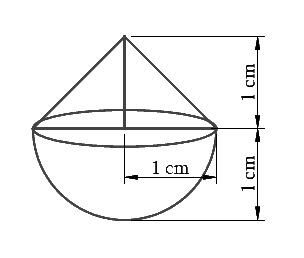
Here r = 1 cm
h = 1 cm.
Now, Volume of solid = Volume of conical part + Volume of hemispherical part
We know the volume of cone = ⅓ πr2h
And,
The volume of the hemisphere = ⅔πr3
Volume of the solid = volume of the conical part + volume of the hemispherical part
= 1/3 πr2h + 2/3 πr3
= 1/3 πr3 + 2/3 πr3 [Since, h = r]
= πr3
= π (1cm)3
= π cm3
Thus, the volume of the solid is π cm3.
2. Rachel, an engineering student, was asked to make a model shaped like a cylinder with two cones attached at its two ends by using a thin aluminium sheet. The diameter of the model is 3 cm, and its length is 12 cm. If each cone has a height of 2 cm, find the volume of air contained in the model that Rachel made. (Assume the outer and inner dimensions of the model are nearly the same.)
Solution – The diagram is as follows.
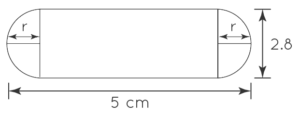
Height of cylinder = 12 – 2 – 2 = 8 cm
Radius = 3/2 = 1.5 cm
Height of cone = 2 cm
Now, the total volume of the air contained will be = Volume of cylinder + 2 × (Volume of the cone)
∴ Total volume = πr2h + [2 × (⅓ πr2h )]
= 18 π + 2(1.5 π)
= 66 cm3.
3. A gulab jamun contains sugar syrup up to about 30% of its volume. Find approximately how much syrup would be found in 45 gulab jamuns, each shaped like a cylinder with two hemispherical ends with a length of 5 cm and a diameter of 2.8 cm (see figure).
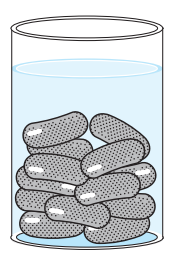
Solution – The diagram is as follows.
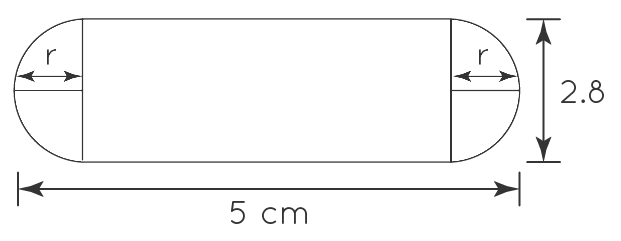
It is known that the gulab jamuns are similar to a cylinder with two hemispherical ends.
So, the total height of a gulab jamun = 5 cm.
Diameter = 2.8 cm
So, radius = 1.4 cm
∴ The height of the cylindrical part = 5 cm – (1.4 + 1.4) cm
= 2.2 cm
Now, the total volume of one gulab jamun = Volume of cylinder + Volume of two hemispheres
= πr2h + (4/3)πr3
= 4.312π + (10.976/3) π
= 25.05 cm3
We know that the volume of sugar syrup = 30% of the total volume
So, the volume of sugar syrup in 45 gulab jamuns = 45 × 30%(25.05 cm3)
= 45 × 7.515
= 338.184 cm3
4. A pen stand made of wood is in the shape of a cuboid with four conical depressions to hold pens. The dimensions of the cuboid are 15 cm by 10 cm by 3.5 cm. The radius of each of the depressions is 0.5 cm, and the depth is 1.4 cm. Find the volume of wood in the entire stand (see Fig.).
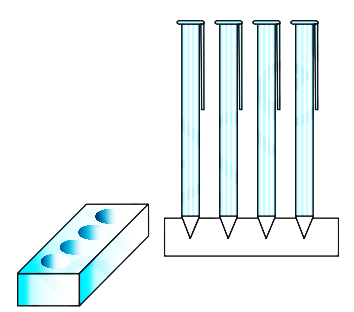
Solution – The volume of the cuboid = length × width × height
We know the cuboid’s dimensions as 15 cm × 10 cm × 3.5 cm
So, the volume of the cuboid = 15 × 10 × 3.5
= 525 cm3
Here, depressions are like cones, and we know,
Volume of cone = (⅓)πr2h
Given, radius (r) = 0.5 cm
depth (h) = 1.4 cm
∴ Volume of 4 cones = 4 × (⅓) πr2h
= 4 × (⅓) × 22/7 × 0.5 × 0.5 × 1.4
= 1.46 cm2
Now, the volume of wood = Volume of the cuboid – 4 ×volume of the cone
= 525 – 1.46
= 523.54 cm2
5. A vessel is in the form of an inverted cone. Its height is 8 cm and the radius of its top, which is open, is 5 cm. It is filled with water up to the brim. When lead shots, each of which is a sphere of radius 0.5 cm, are dropped into the vessel, one-fourth of the water flows out. Find the number of lead shots dropped in the vessel.
Solution – The diagram is as follows.
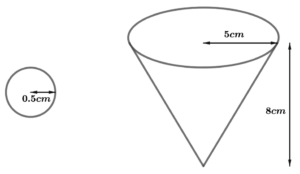
For the cone,
Radius = 5 cm,
Height = 8 cm
Also,
Radius of sphere = 0.5 cm
Volume of water in the vessel = Volume of the conical vessel
Volume of all lead shots dropped into the vessel = 1/4 × Volume of the water in the vessel
Number of lead shots = 1/4 × volume of the water in the vessel ÷ volume of each lead shot
We will find the volume of the water in the vessel and lead shot by using formulae;
Volume of the sphere = 4/3 πr3 (where r is the radius of the sphere)
Volume of the cone = 1/3 πR2h (where R and h are the radius and height of the cone respectively)
Height of the conical vessel, h = 8 cm
Radius of the conical vessel, R = 5 cm
Radius of the spherical lead shot, r = 0.5 cm
Number of lead shots = 1/4 × volume of the water in the vessel ÷ volume of each lead shot
= 1 /4 × (1/3) πR2h ÷ 4 πr3/3
= πR2h/12 × 3/4πr3
= R2h / 16r3
= (5cm × 5 cm × 8 cm) / (16 × 0.5 cm × 0.5 cm × 0.5 cm)
= 100
Thus, the number of lead shots dropped in the vessel is 100.
6. A solid iron pole consists of a cylinder of height 220 cm and base diameter 24 cm, which is surmounted by another cylinder of height 60 cm and radius 8 cm. Find the mass of the pole, given that 1 cm3 of iron has approximately 8 g mass.
Solution – The diagram is as follows.
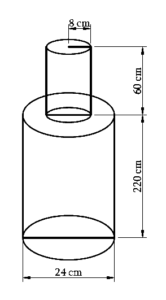
Given the height of the big cylinder (H) = 220 cm
The radius of the base (R) = 24/2 = 12 cm
So, the volume of the big cylinder = πR2H
= π(12)2 × 220 cm3
= 99565.8 cm3
Now, the height of the smaller cylinder (h) = 60 cm
The radius of the base (r) = 8 cm
So, the volume of the smaller cylinder = πr2h
= π(8)2 × 60 cm3
= 12068.5 cm3
∴ The volume of iron = Volume of the big cylinder+ Volume of the small cylinder
= 99565.8 + 12068.5
=111634.5 cm3
We know,
Mass = Density × volume
So, the mass of the pole = 8 × 111634.5
= 893 Kg (approx.)
7. A solid consisting of a right circular cone of height 120 cm and radius 60 cm standing on a hemisphere of radius 60 cm is placed upright in a right circular cylinder full of water such that it touches the bottom. Find the volume of water left in the cylinder if the radius of the cylinder is 60 cm and its height is 180 cm.
Solution – The diagram is as follows.
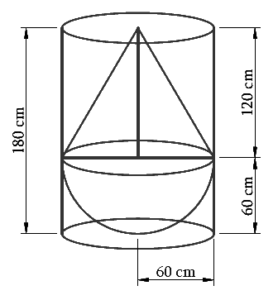
Here, the volume of water left will be = Volume of the cylinder – Volume of solid
Given,
Radius of cone = 60 cm,
Height of cone = 120 cm
Radius of cylinder = 60 cm
Height of cylinder = 180 cm
Radius of hemisphere = 60 cm
Now,
The total volume of solid = Volume of Cone + Volume of the hemisphere
Volume of cone = 1/3πr2h
= 1/3 × π × 602 × 120cm3
= 144×103π cm3
Volume of hemisphere = (⅔) × π × 603 cm3
= 144 × 103π cm3
So, total volume of solid = 144 × 103π cm3 + 144 × 103π cm3
= 288 × 103π cm3
Volume of cylinder = π × 602 × 180
= 648000
= 648 × 103 π cm3
Now, the volume of water left will be = Volume of the cylinder – Volume of solid
= (648 – 288) × 103 × π
= 1.131 m3
8. A spherical glass vessel has a cylindrical neck 8 cm long and 2 cm in diameter; the diameter of the spherical part is 8.5 cm. By measuring the amount of water it holds, a child finds its volume to be 345 cm3. Check whether she is correct, taking the above as the inside measurements and π = 3.14.
Solution – The diagram is as follows.
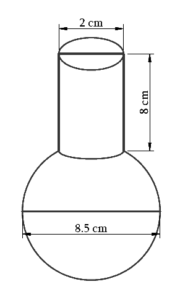
For the cylinder part, Height (h) = 8 cm and Radius (R) = (2/2) cm = 1 cm
For the spherical part, Radius (r) = (8.5/2) = 4.25 cm
Now, volume of this vessel = Volume of cylinder + Volume of sphere
= π × (1)2 × 8 + (4/3)π(4.25)3
= 346.51 cm3
Hence, the child’s calculation is not correct.

Leave a Reply